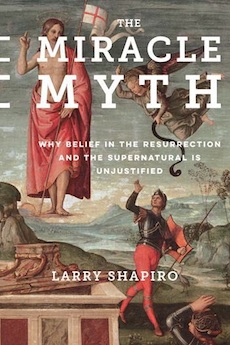By D.T. Siebert
In his book, Larry Shapiro, a professor of philosophy at the University of Wisconsin, mounts a convincing argument against belief in the miraculous. Shapiro doesn’t claim that miracles are necessarily impossible, but rather that they fall far short of justified acceptance. To make his case, he employs amusing analogies and logic, plus historical and even statistical analysis. Although all miraculous occurrences are in his scope of reference, his main target is the resurrection of Jesus Christ, whose evidence he contrasts with verifiable historical events like Julius Caesar’s crossing of the Rubicon.
Much of Shapiro’s attack on the believability of miracles is to be found in David Hume’s much more succinct essay “Of Miracles” (1748). Like Hume’s, Shapiro’s emphasis is on the questionable evidence for miracles and their extreme improbability—that is, that their happening runs counter to all human experience and knowledge of the natural world. Shapiro does briefly acknowledge Hume’s essay as a forerunner of his own arguments.
Shapiro pays close attention to the inconsistencies of the biblical texts, the source for belief in the Christian miracles. The four Gospels we have today are hardly first-hand accounts of Jesus’ life—indeed their writers never knew Jesus and wrote long after his death—nor are they perfect transcriptions of earlier texts. Particularly telling is that Matthew, Mark, Luke (the so-called synoptic Gospels), and John (the one relying on another source) often differ markedly. Indeed, there are many competing texts, and the earliest known copies sometimes lack material now included in the current canonical versions. It seems quite possible that overzealous scribes may have embellished their copies with parables and miracles invented to propagate the Christian religion. Even if one takes the leap of faith that these interpolations are divinely inspired, there is still the question of which Gospel to believe. Biblical textual analysis establishes Mark as the earlier version, the one that Matthew and Luke relied on. But the resurrection story in Mark is not the more detailed account we get in the others: Mark simply ends his account with an empty tomb. (Regarding the reliability of the Scriptures, pages 116-135 in Shapiro are detailed and persuasive.)
One might wish that Shapiro had quoted from Hume, whose text contains many a choice passage, rather than giving him simply an acknowledgement. Hume ends his own argument with clever irony. He deplores those “dangerous friends or disguised enemies to the Christian religion who . . . defend it by the principles of human reason. Our most holy religion is founded on faith, not on reason, and it is a sure method of exposing it to put it to such a trial as it is by no means fitted to endure. . . . We may conclude that the Christian religion not only was at first attended with miracles, but even at this day cannot be believed by any reasonable person without one. Mere reason is insufficient to convince us of its veracity. And whosoever is moved by faith to assent to it is conscious of a continued miracle in his own person which subverts . . . his understanding and gives him a determination to believe what is most contrary to custom and experience.”
Another earlier refutation of the Gospel miracles—one that Shapiro might have mentioned—is in Edward Gibbon’s famous, or infamous, chapter fifteen of The Decline and Fall of the Roman Empire (1776-). For instance, Gibbon, wonders how all the marvelous (or “prodigious”) events recorded in the Gospels escaped the observation of non-Christian historians of that age, or of the elder Pliny and Seneca, who otherwise recorded the great and unusual natural phenomena of their time. Gibbon questions, with sly insinuation: “How can we excuse the supine inattention of the Pagan and philosophic world? . . . The lame walked, the blind saw, the sick were healed, the dead were raised, demons were expelled, and the laws of Nature were frequently suspended. Under the reign of Tiberius, the whole world, or a celebrated province of the Roman empire, was involved in a preternatural darkness of three hours. Even this miraculous event, which ought to have excited the wonder, the curiosity, and the devotion of mankind, passed without notice in an age of science and history.”
Shapiro’s presentation is certainly lively, as if he were trying to keep undergraduates awake and attuned to his jaunty, “with-it” prose. Some readers might object to diction like the following: “stuff,” “ain’t,” “schnozz,” “teensy-weensy,” or Gospels written “by four guys named Matthew, Mark, Luke, and John,” or to this characterization of the miracle of Aaron’s staff becoming a snake: “You would expect [Aaron’s] snake to kick the butts of the sorcerers’ snakes (Do snakes have butts?).” Perhaps other readers might find this colloquial style entertaining and refreshing. In any case, Shapiro’s presentation certainly can’t be faulted for being plodding, pedantic, and dry-as-dust.
D.T. Siebert (ΦBK, University of Oklahoma, 1962) is Distinguished Professor of English Literature Emeritus at the University of South Carolina, Columbia. His recent publications include Mortality’s Muse: The Fine Art of Dying (Delaware, 2013) and the chapter “Hume’s History of England” in the Oxford Handbook of Hume (2016).




